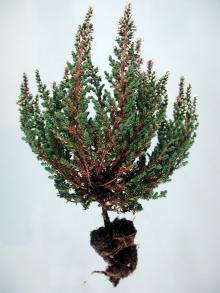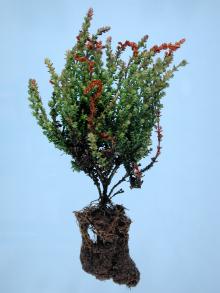Cause The fungus-like microorganism Phytophthora cinnamomi has been reported frequently in Oregon. Waterlogged soils and warm temperatures favor the disease. It survives unfavorable periods in soil and within plant debris. Under favorable conditions, spores germinate and infect roots. After infection, the fungus-like microorganism spreads mainly in the inner bark tissues of the root and stems. They survive as various spores in the soil, container media, or infected roots. Movement of infected plants and/or soil can spread this microorganism.
Symptoms First, the leaves on one or more branches fade, wilt, and die. Foliar symptoms usually are localized, but the entire plant soon dies. Roots are fewer, shorter than normal, and becomes reddish brown as the organism advances up into the root crown. Severe dieback, leaf chlorosis, and defoliation have been observed in New Zealand.
Cultural control
- Provide good water drainage around roots.
- Do not overwater.
- Most species and cultivars need acid soil conditions.
- Use clean potting media.
- Avoid reusing pots from a previous crop for propagation. If pots must be reused then wash off all debris and soak in a sanitizing solution or treat with aerated steam for 30 min.
- Remove and destroy all infected plants and plant debris.
Chemical control Although not specifically registered for this crop, Aliette, Mefenoxam 2 AQ or Subdue may be effective. Try on a few plants first before widespread use.
- Terrazole 35 WP at 3.5 to 10 oz/100 gal water. Group 14 fungicide. 12-hr reentry.
- Truban 30 WP at 3 to 10 oz/100 gal water. Group 14 fungicide. 12-hr reentry.
Reference Robertson, G. I. 1970. Susceptibility of exotic and indigenous trees and shrubs to Phytophthora cinnamomi Rands. New Zealand Journal of Agricultural Research, 13:297-307.




